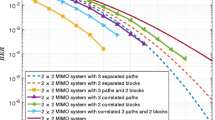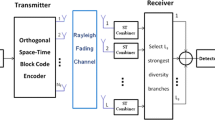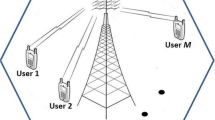Abstract
Multiple input multiple output (MIMO) communication systems with orthogonal frequency division multiplexing (OFDM) has a great role to play for 4G broadband wireless communications. In this paper, a space time frequency (STF) code is presented with reduced decoder complexity and to achieve code rate \(\text{ M }_\mathrm{T}\) with full diversity of \(\text{ M }_{\mathrm{T}} \text{ M }_{\mathrm{R}} \text{ N }_{\mathrm{b}}\) L i.e., product of number of transmit antennas (\(\text{ M }_\mathrm{T}\)), receive antennas \((\text{ M }_{\mathrm{R}})\), fading blocks \((\text{ N }_{\mathrm{b}})\) and channel taps (L). The maximum achievable diversity with high rate of STF block coded MIMO-OFDM is analyzed and verified by simulation results. The decoder complexity is resolved by employing several approaches like maximum likelihood (ML), sphere decoder (SD) and array processing. The performance of STF code is compared with existing layered algebraic STF code in terms of decoder complexity and bit error rate (BER). Further, the closed form expressions for BER performance of STFBC MIMO-OFDM systems are derived and evaluated for frequency selective block fading channels with MPSK constellations.








Similar content being viewed by others
References
Murch, R. D., & Letaief, K. B. (2002). Antenna systems for broadband wireless access. IEEE Communications Magazine, 40, 76–83.
Bolcskei, H. (2006). MIMO-OFDM wireless systems: Basics, perspectives and challenges. IEEE Wireless Communications, 13, 31–37.
Wang, H., & Xia, X. G. (2003). Upper bounds of rates of complex orthogonal space-time block codes. IEEE Transactions on Information Technology, 49, 2788–2796.
Tarokh, V., Seshadri, N., & Calderbank, A. R. (1998). Space-time codes for high data rate wireless communication: Performance criterion and code construction. IEEE Transactions on Information Theory, 44, 744–765.
Alamouti, S. M. (1998). A simple transmit diversity technique for wireless communications. IEEE Journal on Selected Areas in Communications, 16, 1451–1458.
Tarokh, V., Jafarkhani, H., & Calderbank, A. R. (1999). Space-time block codes from orthogonal designs. IEEE Transactions on Information Theory, 45, 1456–1467.
Su, W., & Xia, X. G. (2004). Signal constellations for quasi-orthogonal space-time block codes with full diversity. IEEE Transactions on Information Theory, 50, 2331–2347.
Su, W., Xia, X. G., & Liu, K. J. R. (2004). A systematic design of high-rate complex orthogonal space-time block codes. IEEE Communications Letters, 8, 380–382.
Fellenberg, C., & Rohling, H. (2009). Quadrature amplitude modulation for differential space-time block codes. Springer Wireless Personal Communications, 50, 247–255.
Gupta, B., & Saini, S. D. (2012). Space-time/space-frequency/space-time-frequency block coded MIMO-OFDM system with equalizers in quasi static mobile radio channels using higher tap order. Wireless Personal Communication. doi:10.1007/s11277-012-0672-9.
Wen, H. Gong, & G., Lv, S. C., & Ho, P. H. , (2011). Framework for MIMO cross-layer secure communication based on STBC. Telecommunication Systems. doi:10.1007/s11235-011-9540-2.
Li, Y., & Stuber, G. L. (2007). Orthogonal frequency division multiplexing for wireless communications. Berlin: Springer.
Le, K. N. (2011). Additional insight on SAGE-based carrier and residual frequency offset estimations in OFDM systems. Springer Wireless Personal Communications, 60, 687–694.
Le, K. N. (2010). BER of OFDM in Rayleigh fading environments with selective diversity. Wireless Communications and Mobile Computing, 10, 306–311.
Le, K. N. (2008). Bounds on inter-carrier interference power of OFDM in a Gaussian scattering channel. Springer Wireless Personal Communications, 47, 355–362.
Le, K. N. (2008). Inter-carrier interference power of OFDM in a uniform scattering channel. Computer Communications, 31, 3883–4230.
Le, K. N. (2008). Insights on ICI and its effects on performance of OFDM systems. Digital Signal Processing, 18, 876–884.
Le, K. N., & Dabke, K. P. (2010). BER of OFDM with diversity and pulse shaping in Rayleigh fading environments. Digital Signal Processing, 20, 1687–1696.
Su, W., Safar, Z., Olfat, M., & Liu, K. J. R. (2003). Obtaining full-diversity space-frequency codes from space-time codes via mapping. IEEE Transactions on Signal Processing, 51, 2905–2916.
Su, W., Safar, Z., & Liu, K. J. R. (2005). Full-rate full-diversity space-frequency codes with optimum coding advantage. IEEE Transactions on Information Theory, 51, 229–249.
Huttera, A. A., Mekrazib, S., Getuc, B. N., & Platbrooda, F. (2005). Alamouti-based space-frequency coding for OFDM. Springer Wireless Personal Communications, 35, 173–185.
Molisch, A. F., Win, M. Z., & Winters, J. H. (2002). Space-time-frequency (STF) coding for MIMO-OFDM systems. IEEE Communications Letters, 6, 370–372.
Liu, Z., Xin, Y., & Giannakis, G. (2002). Space-time-frequency coded OFDM over frequency selective fading channels. IEEE Transactions on Signal Processing, 50, 2465–2476.
Su, W., Safar, Z., & Liu, K. J. R. (2005). Towards maximum achievable diversity in space, time and frequency: Performance analysis and code design. IEEE Transactions on Wireless Communications, 4, 1847–1857.
Fozunbal, M., Mclaughlin, S. W., & Schafer, R. W. (2005). On space-time-frequency coding over MIMO-OFDM systems. IEEE Transactions on Wireless Communications, 4, 320–331.
Palou, F. R., Femenias, G., & Ramis, J. (2007). BER analysis of group-orthogonal multicarrier code-division multiplex systems. Springer Wireless Personal Communications, 36, 97–105.
Damen, M. O., & Beaulieu, N. C. (2003). On two high-rate algebraic space time codes. IEEE Transactions on Information Theory, 49, 1059–1063.
Sethuraman, B. A., Rajan, B. S., & Shashidhar, V. (2003). Full-diversity, high-rate space-time block codes from division algebras. IEEE Transactions on Information Theory, 49, 2596–2616.
Zhang, W., Xia, X. G., & Ching, P. C. (2004). A design of high rate space frequency codes for MIMO-OFDM systems. In Proceedings of the IEEE Global Telecommunication Conference, pp. 209–213.
Zhang, W., Xia, X. G., Ching, P. C., & Wang, H. (2005). Rate two full diversity space frequency code design for MIMO-OFDM. In Proceedings of the IEEE 6th workshop on signal processing advances in wireless communications, pp. 321–325.
Kiran, T., & Rajan, B. S. (2005). A systematic design of high rate full diversity space frequency codes for MIMO-OFDM systems. In Proceedings of the International Symposium on Information Theory, pp. 2075–2079.
Biglieri, E., Caire, G., & Taricco, G. (2001). Limiting performance for block fading channels with multiple antennas. IEEE Transactions on Information Theory, 47, 1273–1289.
El Gamal, H., & Hammons, A. R, Jr. (2003). On the design of algebraic space time codes for MIMO block fading channels. IEEE Transactions on Information Theory, 49, 151–163.
Zhang, W., Xia, X. G., & Ching, P. C. (2007). High rate full diversity space time frequency codes for broadband MIMO block fading channels. IEEE Transactions on Communications, 55, 25–34.
Jakes, W. C. (1975). Microwave mobile communications. London: Wiley.
Holakouei, R., Silva, A., & Gameiro, A. (2011). Multiuser precoding techniques for a distributed broadband wireless system. Telecommunication Systems. doi:10.1007/s11235-011-9496-2.
Giraud, X., Boutillon, E., & Belfiore, J. C. (1997). Algebraic tools to build modulation schemes for fading channels. IEEE Transactions on Information Technology, 43, 938–952.
Xia, X. (2001). Precoded and vector OFDM robust to channel spectral nulls and with reduced cyclic prefix length in single transmit antenna system. IEEE Transactions on Communications, 49, 1363–1374.
Proakis, J. G. (2001). Digital communications. New York: McGraw-Hill.
Chung, S. T., & Goldsmith, A. J. (2001). Degrees of freedom in adaptive modulation: A unified view. IEEE Transactions on Communications, 49, 1561–1571.
Torabi, M., Aissa, S., & Soleymani, M. R. (2007). On the BER performance of space frequency block coded OFDM systems in fading MIMO channels. IEEE Transactions on Wireless Communications, 6, 1366–1373.
Chang, T. H., Ma, W. K., & Chi, C. Y. (2008). Maximum-likelihood detection of orthogonal space-time block coded OFDM in unknown block fading channels. IEEE Transactions on Signal Processing, 56, 1637–1649.
Rezk, M., & Friedlander, B. (2011). On high performance MIMO communications with imperfect channel knowledge. IEEE Transactions on Wireless Communications, 10, 602–613.
Viterbo, E., & Boutros, J. (1999). A universal lattice code decoder for fading channel. IEEE Transactions on Information Theory, 45, 1639–1642.
Hajiani, P., & Shafiee, H. (2005). Low complexity sphere decoding for space-frequency-coded MIMO-OFDM systems. In Proceedings of the second IFIP international conference on wireless and optical communications, networks, pp. 410–414.
Zheng, C., Chu, X., McAllister, J., & Woods, R. (2011). Real-valued fixed-complexity sphere decoder for high dimensional QAM-MIMO systems. IEEE Transactions on Signal Processing, 59, 4493–4499.
Tarokh, V., Naguib, A., Seshadri, N., & Calderbank, A. R. (1999). Combined array processing and space time coding. IEEE Transactions on Information Theory, 45, 1121–1128.
Jiang, C., Zhang, H., Yuan, D., & Chen, H. H. (2008). A low complexity decoding scheme for quasi-orthogonal space-time block coding. In Proceedings of the 5th IEEE workshop on sensor array multi-channel, signal processing, pp. 9–12.
Zhang, H., Yuan, D., & Chen, H. H. (2010). On array processing based quasi-orthogonal space time block coded OFDM systems. IEEE Transactions on Vehicular Technology, 59, 508–513.
Author information
Authors and Affiliations
Corresponding author
Rights and permissions
About this article
Cite this article
Gupta, B., Saini, D.S. A Rate \(\text{ M }_{\mathrm{T}}\) Full Diversity STF Block Coded \(4\times 4\) MIMO-OFDM System with Reduced Complexity. Wireless Pers Commun 72, 1489–1512 (2013). https://doi.org/10.1007/s11277-013-1092-1
Published:
Issue Date:
DOI: https://doi.org/10.1007/s11277-013-1092-1




